An Overview on LCA Integration in BIM: Tools, Applications, and Future Trends
Abstract
1. Introduction
2. Materials and Methods
- What are the most commonly adopted workflows in the scientific literature for integrating LCA evaluations into BIM processes?
- Which databases and environmental data sources are most frequently employed for conducting LCA within BIM models?
- What automation systems and tools are currently utilized to facilitate the generation and management of LCA evaluations in BIM workflows, and what emerging technologies (e.g., NLP and LLMs) have been explored?
- What strategies have been proposed in the literature to improve interoperability between BIM and LCA software, the standardization of environmental data, and the overall efficiency of integrated processes?
- What are the main technical and informational barriers hindering full integration between BIM and LCA, and to what extent do these challenges affect practical implementation in design environments?
- What techniques and tools are currently employed to visualize environmental data in digital models, and how do these contribute to supporting decision-making processes during the early design stages?
- BIM–LCA Workflows: The main workflows identified in the literature are examined, with attention to emerging approaches.
- Automation and Optimization: The potential offered by the integration of computational models, algorithms, and BIM–LCA tools is investigated.
- Data Standardization: The role of EPDs and international initiatives in harmonizing environmental information is examined.
- Data Visualization: Techniques and tools for transforming quantitative data into accessible visual representations are investigated.
- Limitations and Barriers: Analysis of issues related to the quality, accessibility, and interoperability of environmental data are conducted.
- Future Perspectives: Development directions to enhance the quality of EPDs, the automation of processes, and the communication of environmental outcomes are suggested.
Research Methodology
- Peer-reviewed studies published between January 2010 and May 2025;
- Articles written in English;
- Studies focusing on the integration of BIM and LCA;
- Presence of descriptions of workflows, software tools, LCA phases, and/or visualization strategies;
- Applications at the building scale.
- Absence of actual BIM–LCA integration;
- Generic or theoretical studies lacking practical applications;
- Non-construction sectors (e.g., manufacturing or infrastructure);
- Non-accessible or non-scientific documents (technical reports or popular articles).
3. Results
3.1. Bibliometric Analysis and Visualization of Research Topics
- Green Cluster (Environmental Topics and LCA): This cluster includes terms such as Life Cycle Assessment (LCA), global warming potential, environmental impact, energy efficiency, and greenhouse gases. It centers on environmental analysis and the application of LCA to evaluate the sustainability performance of construction materials and building projects. Despite the extensive coverage of these topics, the literature frequently overlooks issues related to the availability and quality of Environmental Product Declaration (EPD) data, particularly in developing countries. This gap represents a significant barrier to the global scalability and applicability of BIM–LCA methodologies.
- Blue Cluster (BIM and Design): This cluster comprises terms such as BIM, building design, intelligent buildings, interoperability, and machine learning. It explores how the literature addresses the integration of BIM with decision-support and data management tools. However, the adoption of interoperable standards remains fragmented, and the investigation into the effective automation of LCA workflows through such technologies appears limited. The marginal presence of concepts like interoperability and data quality suggests the need for more systematic studies on the standardization of environmental data.
- Grey Cluster (Digital Technologies and Visualization): This cluster is defined by terms such as data visualization, virtual reality, big data, and simulation. It reflects a growing interest in the interactive representation of data and the use of immersive technologies to enhance stakeholder understanding of environmental outcomes. Nonetheless, many of these applications remain at an experimental stage, and the integration between visualization tools and decision-making processes is not yet fully developed in the existing body of research.
3.2. Scientific Literature Classification on BIM–LCA Integration
3.2.1. Framework for BIM–LCA Integration Workflows
- Export of Bill of Quantities (BoQ):
- 2.
- Import of surfaces via IFC:
- 3.
- Transfer of BIM data to dedicated LCA software:
- 4.
- Use of BIM-specific plug-ins:
- 5.
- Direct integration of LCA information into BIM objects:
3.2.2. Automation and Optimization
3.2.3. Database and Data Standardization
3.2.4. Analysis of the Most Investigated Modules in the Case Studies
3.2.5. Data Visualization
4. Discussion
5. Conclusions
Author Contributions
Funding
Data Availability Statement
Acknowledgments
Conflicts of Interest
Abbreviations
| AEC | Architecture, Engineering, and Construction |
| AI | Artificial intelligence |
| BIM | Building Information Modeling |
| BoQ | Bill of Quantities |
| CSVs | Comma-Separated Values |
| DGNB | German Sustainable Building Council |
| EPD | Environmental Product Declaration |
| EoL | End-of-life |
| GBRS | Green Building Rating Systems |
| GWP | Global warming potential |
| IFCs | Industry Foundation Classes |
| IPCC | Intergovernmental Panel on Climate Change |
| ISO | International Organization for Standardization |
| LCA | Life Cycle Assessment |
| LCC | Life Cycle Costing |
| LCI | Life Cycle Inventory |
| LOD | Level of development |
| LOIN | Level of Information Need |
| LLM | Large language model |
| ML | Machine learning |
| NLP | Natural Language Processing |
| NSGA-II | Non-dominated Sorting Genetic Algorithm II |
| PCRs | Product Category Rules |
| QTO | Quantity take-off |
| SVM | Support Vector Machine |
| VR | Virtual reality |
Appendix A
| Authors | Ref | Software | Building Typology | Data Sources | LCA Phases (A1–A3, A4–A5, B1–B7, C1–C4, D) | BIM–LCA Integration Methods | Visualization |
|---|---|---|---|---|---|---|---|
| Ajtayné Károlyfi et al., 2023 | [42] | Rhinoceros, Grasshopper, ConSteel (Pangolin), Archicad | Steel Frame Structure | ÖKOBAUDAT | A1–A3 | 5 | Bar charts |
| Alotaibi et al., 2022 | [38] | Revit, One Click LCA | Residential Building | One Click LCA Database | A1–A3, A4–A5, B1, B6, B7, C1–C4 | 4 | Bar charts |
| Alwan et al. | [57] | Grasshopper, EnergyPlus, Bombyx | Residential Building | UK (ICE), OE Database (EnergyPlus+) | A1–A3, B6 | 1 | Bar charts, 3D visualization |
| Ansah et al., 2021 | [44] | Revit, Dynamo, Excel | Prefabricated/Modular Multi-Story Buildings | Functional Database (Hong Kong), Ecoinvent, Supplementary Data, Local Emission Factors | A1–A3, A4–A5, B1–B7, C1–C4, D | 5 | Bar charts |
| Arvizu-Piña et al., 2023 | [26] | Revit, Excel, EVAMED | Residential Building | MEXICANIUH, Ecoinvent | A1–A3, A4–A5, B4, B6, C1 | 1 | 3D visualization |
| Bertin et al., 2020 | [50] | Revit, Dynamo, Grasshopper | Multi-Story Buildings | Reused Structural Elements Material Database | A1–A3 | 5 | Table |
| Boje et al., 2023 | [35] | Brightway, Ecoinvent EF v3.0 | Office Building | Ecoinvent, Luxembourg/Germany-Specific Data | Scenario 1. (A1–A3) Scenario 2. Monthly utility operational usage (B6) Scenario 3. LCSA for modules (A1–A3, B6, B7) | 2 | Bar charts, Charts |
| Cavalliere et al., 2018 | [18] | SimaPro | New Multi-Dwelling Building | Ecoinvent | A1–A3, B4, C3 C4 | 5 | Bar charts |
| Cavalliere et al., 2019 | [9] | Rhinoceros | Multi-Family House | Generic Database, KBOB | A1–A3, B4, C3, C4 | 1 | 3Dvisualization |
| Chen et al., 2024 | [29] | LLM, COMPAS, GPT-4, Revit, Dynamo | Office Building | KBOB | A1–A4 | 1 | Table |
| Cheng et al., 2020 | [19] | Revit, DesignBuilder | Museum | Chinese Life Cycle Database (CLCD) | A1–A3, B1–B7, C4, D | 1 | Bar charts, Charts |
| Cheng et al., 2022 | [20] | Revit, Excel, Dynamo | Cultural and Sports Center | IEA EBC | A1–A5, B4, C1–C4 | 1 | Bar charts, Charts |
| Di Santo et al., 2023 | [27] | Revit, AH-LCA | Residential Building | Database Materials, EPDs | A1–A3, B1–B6, C1–C4 | 1 | Bar charts |
| Fernández Rodríguez et al., 2025 | [21] | Revit, SimaPro, Athena Impact Estimator | Industrial Warehouse | Ecoinvent 3 (SimaPro), Athena Database | A1–A3, A4–A5, B1, B6, B7 | 1 | Bar charts |
| Felicioni et al., 2023 | [23] | Revit, One Click LCA, DesignStudio | Residential Building | EPD | A1–A5, B4–B6, C2–C3 | 1 | Bar charts, Charts |
| Forth et al., 2023 | [30] | Revit, IFC, BERT | Office Building | LKdb ÖKOBAUDAT | A1–A3 B3, B4, B5, C1, C2, C3, C4 | 2 | 3D visualization, Bar charts |
| Forth et al., 2023 | [31] | IFC, NLP | 5 Case Studies | LCA Knowledge Database (LKdb), ÖKOBAUDAT, BNB Life Cycle, EPD | A1–A3, B4, C3, C4, D | 2 | Bar charts |
| Forth et al., 2023 | [32] | IFC, Web Server (HTML, JavaScript, CSS) | Office Building | ÖKOBAUDAT, LKdb | A1–A3, B4, C3, C4, D | 2 | 3D visualization, Bar charts |
| Gu et al., 2025 | [28] | Revit, Excel, Claude 3.5, GPT-4o, Word2Vec, Glodon GTJ2024 | Mixed-Use Commercial-Residential Building | Chinese Life Cycle Database (CLCD) | A1–A5 | 1 | Bar charts, Charts |
| Kiamili et al., 2020 | [48] | Revit, Dynamo | Office Building | KBOB, Ecoinvent | A1–A3, B4, B6, C1–C3 | 5 | Bar charts |
| Kyaw et al., 2025 | [58] | Revit | Single-Family House | Norwegian EPD (EPD Norge), Ecoinvent | A1–A3 | 1 | Bar charts |
| Lee et al., 2021 | [46] | Revit | Residential Building | EPD (BTEI Library including Impact and Cost Data) | A1–A3, B1–B5 | 5 | Bar charts |
| Li et al., 2023 | [47] | Revit, IBLAT | Elementary School | CLCD, Ecoinvent, ÖKOBAUDAT | A1–A3, A4, A5, B4, B6, C4 | 5 | Bar charts |
| Lu et al., 2019 | [36] | Revit, GTJ2018, Green Building Studio | Hospital | Chinese Life Cycle Database (CLCD), CEC Database | A1–A5, B1–B7, C1–C4 | 3 | Bar charts, Charts |
| Ma et al., 2024 | [51] | Revit, Tally | Office Building | Tally Database | A1–A3, A4, C2–C4, D | 4 | Bar charts |
| Martínez-Rocamora et al., 2021 | [52] | Revit, Tally, Excel, Python (Scikit-learn) | Residential Building | GaBi | A1, B2, B4, C4, D | 4 | Bar charts |
| Mohammed et al., 2025 | [53] | Revit, eToolLCD, Tally, Excel | Factory | EPDs, eToolLCD, GaBi | A1–A3, A4, C2–C4, D | 4 | Barcharts |
| Mowafy et al., 2023 | [43] | Revit, Rhino.Inside, Grasshopper, Bombyx, Wallacei X, OSDEA, EMS | Residential Building | KBOB | A1–A3, B4, C3–C4 | 5 | 3D visualization, Bar charts, Charts |
| Najjar et al., 2017 | [34] | Revit | Office Building | GaBi | A1–A3, A4, C2–C4, D | 4 | Bar charts |
| Naneva et al., 2020 | [25] | Revit, Dynamo | Office Building | Bauteilkatalog, KBOB, Ecoinvent | A1–A3, B4, C3–C4 | 1 | 3D visualization, Bar charts |
| Nehasilová et al., 2022 | [37] | Archicad, Revit, SimaPro, DEK Building Library | Residential Building | Ecoinvent | A1–A3 | 3 | Table |
| Noorzai et al., 2023 | [40] | Revit, Rhino, Grasshopper, EnergyPlus, Athena Impact Estimator, Dynamo | Residential Building | Athena | A1–A5, B6 | 4 | Bar charts, Charts |
| Palumbo et al., 2020 | [10] | Generic BIM Software | Office Building | Ecoinvent, GaBi, EPD | A1–A3 | 1 | Bar charts |
| Płoszaj-Mazurek et al., 2024 | [33] | Rhino, Grasshopper, Keras, ChatGPT, SLAD.AI | Residential Building | ÖKOBAUDAT | A1–A3, B6, C3–C4, D | 2 | 3D visualization, Bar charts, Charts |
| Röck et al., 2018 | [49] | Revit, Excel, Dynamo | Residential Building | Generic Database | A1–A3 | 5 | 3D visualization, Bar charts |
| Růžička et al., 2022 | [34] | IFC, SBToolCZ | Residential Building | Generic Database | A1–A3 | 2 | Table |
| Sandberg et al., 2019 | [55] | Revit, IFC, Grasshopper GeometryGymIFC, Ladybug Tools, Slingshot, MySQL, EnergyPlus, Octopus | Residential Building | ICE, EPD, Swedish District Heating Association | A1–A3, B6 | 4 | Charts |
| Santos et al., 2019 | [11] | Revit, IFC | Residential Building | EPD, Ecoinvent | A1–A5, B2–B4, C2–C4, D | 5 | Table |
| Santos et al., 2020 | [59] | Revit, BIMEELCA, Tally, Athena | Office Building | IBU, ÖKOBAUDAT, MRPI, Ecoinvent, GaBi, Athena | A1–A4, B2–B5, B6, C2–C4, D | 4 | Bar charts |
| Schneider-Marin et al., 2020 | [41] | IFC, SQL Database | Office Building | ÖKOBAUDAT | A1–A3, B4, C3–C4, D | 2 | Bar charts |
| Soust-Verdaguer et al., 2018 | [22] | Archicad, Excel, EnergyPlus | Residential Building | Ecoinvent | A1–A5, B2–B4, B6, C1–C2, C4, D | 1 | Bar charts |
| Van Eldik et al., 2020 | [24] | Revit, Excel, Dynamo | Infrastructure Design Project | EIA Database | A1–A5, B2–B4, C1–C4 | 1 | 3D visualization, Bar charts |
| Xu et al., 2022 | [45] | Revit, SimaPro, Python | Residential Building | SimaPro Databases | A1–A5 | 2 | Bar charts, Charts |
References
- Mitigation of Climate Change Climate Change 2022 Working Group III Contribution to the Sixth Assessment Report of the Intergovernmental Panel on Climate Change. 2022. Available online: www.ipcc.ch (accessed on 27 February 2024).
- Backes, J.G.; Hinkle-Johnson, R.; Traverso, M. The influence of the Functional Unit on the comparability of life cycle assessments in the construction sector: A Systematic Literature Review and attempt at unification for Reinforced Concrete. Case Stud. Constr. Mater. 2023, 18, e01966. [Google Scholar] [CrossRef]
- ISO 14040:2006; Environmental Management—Life Cycle Assessment—Principles and Framework. ISO: Geneva, Switzerland, 2006.
- ISO 14044:2006; Environmental Management—Life Cycle Assessment—Requirements and Guidelines. ISO: Geneva, Switzerland, 2006.
- EN 15978:2011; Sustainability of Construction Works—Assessment of Environmental Performance of Buildings—Calculation Method. CEN: Brussels, Belgium, 2011.
- ISO 19650-1:2018; Organization and Digitization of Information About Buildings and Civil Engineering Works, Including Building Information Modelling (BIM)–Information Management Using Building Information Modelling—Part 1: Concepts and Principles. ISO: Geneva, Switzerland, 2018.
- ISO 22057:2022; Sustainability in Buildings and Civil Engineering Works—Data Templates for the Use of Environmental Product Declarations (EPDs) for Construction Products in Building Information Modelling. ISO: Geneva, Switzerland, 2022.
- Guignone, G.; Calmon, J.L.; Vieira, D.; Bravo, A. BIM and LCA integration methodologies: A critical analysis and proposed guidelines. J. Build. Eng. 2023, 73, 106780. [Google Scholar] [CrossRef]
- Cavalliere, C.; Habert, G.; Dell’Osso, G.R.; Hollberg, A. Continuous BIM-based assessment of embodied environmental impacts throughout the design process. J. Clean. Prod. 2019, 211, 941–952. [Google Scholar] [CrossRef]
- Palumbo, E.; Soust-Verdaguer, B.; Llatas, C.; Traverso, M. How to Obtain Accurate Environmental Impacts at Early Design Stages in BIM When Using Environmental Product Declaration. A Method to Support Decision-Making. Sustainability 2020, 12, 6927. [Google Scholar] [CrossRef]
- Santos, R.; Costa, A.A.; Silvestre, J.D.; Pyl, L. Integration of LCA and LCC analysis within a BIM-based environment. Autom. Constr. 2019, 103, 127–149. [Google Scholar] [CrossRef]
- Durão, V.; A Costa, A.; Silvestre, J.D.; Mateus, R.; de Brito, J. Integration of environmental life cycle information in BIM objects according with the level of development. IOP Conf. Ser. Earth Environ. Sci. 2019, 225, 012075. [Google Scholar] [CrossRef]
- Almeida, R.; Chaves, L.; Silva, M.; Carvalho, M.; Caldas, L. Integration between BIM and EPDs: Evaluation of the main difficulties and proposal of a framework based on ISO 19650:2018. J. Build. Eng. 2023, 68, 106091. [Google Scholar] [CrossRef]
- German Sustainable Building Council|DGNB. Available online: https://www.dgnb.de/en (accessed on 1 March 2024).
- Antón, L.Á.; Díaz, J. Integration of LCA and BIM for Sustainable Construction. Int. J. Civ. Environ. Eng. 2014, 8, 1378–1382. [Google Scholar] [CrossRef]
- Page, M.J.; McKenzie, J.E.; Bossuyt, P.M.; Boutron, I.; Hoffmann, T.C.; Mulrow, C.D.; Shamseer, L.; Tetzlaff, J.M.; Akl, E.A.; Brennan, S.E.; et al. The PRISMA 2020 statement: An updated guideline for reporting systematic reviews. BMJ 2021, 372, 71. [Google Scholar] [CrossRef] [PubMed]
- Wastiels, L.; Decuypere, R. Identification and comparison of LCA-BIM integration strategies. IOP Conf. Ser. Earth. Environ. Sci. 2019, 323, 012101. [Google Scholar] [CrossRef]
- Cavalliere, C.; Dell’Osso, G.R.; Pierucci, A.; Iannone, F. Life cycle assessment data structure for building information modelling. J. Clean. Prod. 2018, 199, 193–204. [Google Scholar] [CrossRef]
- Cheng, B.; Li, J.; Tam, V.W.Y.; Yang, M.; Chen, D.A. BIM-LCA Approach for Estimating the Greenhouse Gas Emissions of Large-Scale Public Buildings: A Case Study. Sustainability 2020, 12, 685. [Google Scholar] [CrossRef]
- Cheng, B.; Lu, K.; Li, J.; Chen, H.; Luo, X.; Shafique, M. Comprehensive assessment of embodied environmental impacts of buildings using normalized environmental impact factors. J. Clean. Prod. 2022, 334, 130083. [Google Scholar] [CrossRef]
- Rodríguez, J.F.F.; Picardo, A.; Aguilar-Planet, T.; Martín-Mariscal, A.; Peralta, E. Data Transfer Reliability from Building Information Modeling (BIM) to Life Cycle Assessment (LCA)—A Comparative Case Study of an Industrial Warehouse. Sustainability 2025, 17, 1685. [Google Scholar] [CrossRef]
- Soust-Verdaguer, B.; Llatas, C.; García-Martínez, A.; de Cózar, J.C.G. BIM-Based LCA Method to Analyze Envelope Alternatives of Single-Family Houses: Case Study in Uruguay. J. Archit. Eng. 2018, 24, 05018002. [Google Scholar] [CrossRef]
- Felicioni, L.; Gaspari, J.; Veselka, J.; Malík, Z. A comparative cradle-to-grave life cycle approach for addressing construction design choices: An applicative case study for a residential tower in Aalborg, Denmark. Energy Build. 2023, 298, 113557. [Google Scholar] [CrossRef]
- van Eldik, M.A.; Vahdatikhaki, F.; dos Santos, J.M.O.; Visser, M.; Doree, A. BIM-based environmental impact assessment for infrastructure design projects. Autom. Constr. 2020, 120, 103379. [Google Scholar] [CrossRef]
- Naneva, A.; Bonanomi, M.; Hollberg, A.; Habert, G.; Hall, D. Integrated BIM-Based LCA for the Entire Building Process Using an Existing Structure for Cost Estimation in the Swiss Context. Sustainability 2020, 12, 3748. [Google Scholar] [CrossRef]
- Arvizu-Piña, V.A.; López, J.F.A.; González, A.A.G.; Alarcón, I.G.B. An open access online tool for LCA in building’s early design stage in the Latin American context. A screening LCA case study for a bioclimatic building. Energy Build. 2023, 295, 113269. [Google Scholar] [CrossRef]
- Di Santo, N.; Henriquez, L.G.; Dotelli, G.; Imperadori, M. Holistic Approach for Assessing Buildings’ Environmental Impact and User Comfort from Early Design: A Method Combining Life Cycle Assessment, BIM, and Active House Protocol. Buildings 2023, 13, 1315. [Google Scholar] [CrossRef]
- Gu, X.; Chen, C.; Fang, Y.; Mahabir, R.; Fan, L. Ceca: An Intelligent Large-Language-Model-Enabled Method for Accounting Embodied Carbon in Buildings. Build. Environ. 2025, 272, 112694. [Google Scholar] [CrossRef]
- Chen, L.; Silvennoinen, H.D.W.; Catherine, H.; Daniel Van Mele, T.; Block, P. Towards Automated Building Life Cycle Assessments: A Novel Approach Using Large Language Models and the COMPAS Framework. In Proceedings of the IASS 2024 Symposium, Zurich, Switzerland, 26–30 August 2024. [Google Scholar]
- Forth, K.; Hollberg, A.; Borrmann, A. BIM4EarlyLCA: An interactive visualization approach for early design support based on uncertain LCA results using open BIM. Dev. Built Environ. 2023, 16, 100263. [Google Scholar] [CrossRef]
- Forth, K.; Abualdenien, J.; Borrmann, A. Calculation of embodied GHG emissions in early building design stages using BIM and NLP-based semantic model healing. Energy Build. 2023, 284, 112837. [Google Scholar] [CrossRef]
- Forth, K.; Borrmann, A.; Hollberg, A. Interactive visualization of uncertain embodied GHG emissions for design decision support in early stages using open BIM. In Life-Cycle of Structures and Infrastructure Systems; CRC Press: Boca Raton, FL, USA, 2023; pp. 3634–3641. [Google Scholar] [CrossRef]
- Płoszaj-Mazurek, M.; Ryńska, E. Artificial Intelligence and Digital Tools for Assisting Low-Carbon Architectural Design: Merging the Use of Machine Learning, Large Language Models, and Building Information Modeling for Life Cycle Assessment Tool Development. Energies 2024, 17, 2997. [Google Scholar] [CrossRef]
- Růžička, J.; Veselka, J.; Rudovský, Z.; Vitásek, S.; Hájek, P. BIM and Automation in Complex Building Assessment. Sustainability 2022, 14, 2237. [Google Scholar] [CrossRef]
- Boje, C.; Menacho, Á.J.H.; Marvuglia, A.; Benetto, E.; Kubicki, S.; Schaubroeck, T.; Gutiérrez, T.N. A framework using BIM and digital twins in facilitating LCSA for buildings. J. Build. Eng. 2023, 76, 107232. [Google Scholar] [CrossRef]
- Lu, K.; Jiang, X.; Tam, V.W.Y.; Li, M.; Wang, H.; Xia, B.; Chen, Q. Development of a Carbon Emissions Analysis Framework Using Building Information Modeling and Life Cycle Assessment for the Construction of Hospital Projects. Sustainability 2019, 11, 6274. [Google Scholar] [CrossRef]
- Nehasilová, M.; Lupíšek, A.; Coufalová, P.L.; Kupsa, T.; Veselka, J.; Vlasatá, B.; Železná, J.; Kunová, P.; Volf, M. Rapid Environmental Assessment of Buildings: Linking Environmental and Cost Estimating Databases. Sustainability 2022, 14, 10928. [Google Scholar] [CrossRef]
- Alotaibi, B.S.; Khan, S.A.; Abuhussain, M.A.; Al-Tamimi, N.; Elnaklah, R.; Kamal, M.A. Life Cycle Assessment of Embodied Carbon and Strategies for Decarbonization of a High-Rise Residential Building. Buildings 2022, 12, 1203. [Google Scholar] [CrossRef]
- Najjar, M.; Figueiredo, K.; Palumbo, M.; Haddad, A. Integration of BIM and LCA: Evaluating the environmental impacts of building materials at an early stage of designing a typical office building. J. Build. Eng. 2017, 14, 115–126. [Google Scholar] [CrossRef]
- Atashbar, H.; Noorzai, E. Optimization of Exterior Wall Cladding Materials for Residential Buildings Using the Non-Dominated Sorting Genetic Algorithm II (NSGAII) Based on the Integration of Building Information Modeling (BIM) and Life Cycle Assessment (LCA) for Energy Consumption: A Case Study. Sustainability 2023, 15, 15647. [Google Scholar] [CrossRef]
- Schneider-Marin, P.; Harter, H.; Tkachuk, K.; Lang, W. Uncertainty Analysis of Embedded Energy and Greenhouse Gas Emissions Using BIM in Early Design Stages. Sustainability 2020, 12, 2633. [Google Scholar] [CrossRef]
- Károlyfi, K.A.; Szép, J. A Parametric BIM Framework to Conceptual Structural Design for Assessing the Embodied Environmental Impact. Sustainability 2023, 15, 11990. [Google Scholar] [CrossRef]
- Mowafy, N.; El Zayat, M.; Marzouk, M. Parametric BIM-based life cycle assessment framework for optimal sustainable design. J. Build. Eng. 2023, 75, 106898. [Google Scholar] [CrossRef]
- Ansah, M.K.; Chen, X.; Yang, H.; Lu, L.; Lam, P.T.I. Developing an automated BIM-based life cycle assessment approach for modularly designed high-rise buildings. Environ. Impact Assess. Rev. 2021, 90, 106618. [Google Scholar] [CrossRef]
- Xu, J.; Teng, Y.; Pan, W.; Zhang, Y. BIM-integrated LCA to automate embodied carbon assessment of prefabricated buildings. J. Clean. Prod. 2022, 374, 133894. [Google Scholar] [CrossRef]
- Lee, S.; Tae, S.; Jang, H.; Chae, C.U.; Bok, Y. Development of building information modeling template for environmental impact assessment. Sustainability 2021, 13, 3092. [Google Scholar] [CrossRef]
- Li, Q.; Yang, W.; Kohler, N.; Yang, L.; Li, J.; Sun, Z.; Yu, H.; Liu, L.; Ren, J. A BIM–LCA Approach for the Whole Design Process of Green Buildings in the Chinese Context. Sustainability 2023, 15, 3629. [Google Scholar] [CrossRef]
- Kiamili, C.; Hollberg, A.; Habert, G. Detailed Assessment of Embodied Carbon of HVAC Systems for a New Office Building Based on BIM. Sustainability 2020, 12, 3372. [Google Scholar] [CrossRef]
- Röck, M.; Hollberg, A.; Habert, G.; Passer, A. LCA and BIM: Visualization of environmental potentials in building construction at early design stages. Build. Environ. 2018, 140, 153–161. [Google Scholar] [CrossRef]
- Bertin, I.; Mesnil, R.; Jaeger, J.M.; Feraille, A.; Le Roy, R. A BIM-Based Framework and Databank for Reusing Load-Bearing Structural Elements. Sustainability 2020, 12, 3147. [Google Scholar] [CrossRef]
- Ma, L.; Azari, R.; Elnimeiri, M. A Building Information Modeling-Based Life Cycle Assessment of the Embodied Carbon and Environmental Impacts of High-Rise Building Structures: A Case Study. Sustainability 2024, 16, 569. [Google Scholar] [CrossRef]
- Martínez-Rocamora, A.; Rivera-Gómez, C.; Galán-Marín, C.; Marrero, M. Environmental benchmarking of building typologies through BIM-based combinatorial case studies. Autom. Constr. 2021, 132, 103980. [Google Scholar] [CrossRef]
- Mohammed, A.; Elmasoudi, I.; Ghannam, M. Life cycle environmental impact assessment of steel structures using building information modeling. Innov. Infrastruct. Solut. 2025, 10, 36. [Google Scholar] [CrossRef]
- Martínez-Rocamora, A.; Solís-Guzmán, J.; Marrero, M. LCA databases focused on construction materials: A review. Renew. Sustain. Energy Rev. 2016, 58, 565–573. [Google Scholar] [CrossRef]
- Sandberg, M.; Mukkavaara, J.; Shadram, F.; Olofsson, T. Multidisciplinary optimization of life-cycle energy and cost using a BIM-based master model. Sustainability 2019, 11, 286. [Google Scholar] [CrossRef]
- Baehr, J.; Koyamparambath, A.; Dos Reis, E.; Weyand, S.; Binnig, C.; Schebek, L.; Sonnemann, G. Predicting product life cycle environmental impacts with machine learning: Uncertainties and implications for future reporting requirements. Sustain. Prod. Consum. 2024, 52, 511–526. [Google Scholar] [CrossRef]
- Kyaw, K.S.S.; Huang, L.; Liu, Y.; Bohne, R.A. Influences of BIM-LOD and Geographic-Scale Environmental Impact Factors on embodied emissions: The Norwegian context. Build. Environ. 2024, 269, 112345. [Google Scholar] [CrossRef]
- Santos, R.; Costa, A.A.; Silvestre, J.D.; Vandenbergh, T.; Pyl, L. BIM-based life cycle assessment and life cycle costing of an office building in Western Europe. Build. Environ. 2020, 169, 106568. [Google Scholar] [CrossRef]
- Alwan, Z.; Nawarathna, A.; Ayman, R.; Zhu, M.; ElGhazi, Y. Framework for parametric assessment of operational and embodied energy impacts utilising BIM. J. Build. Eng. 2021, 42, 102768. [Google Scholar] [CrossRef]
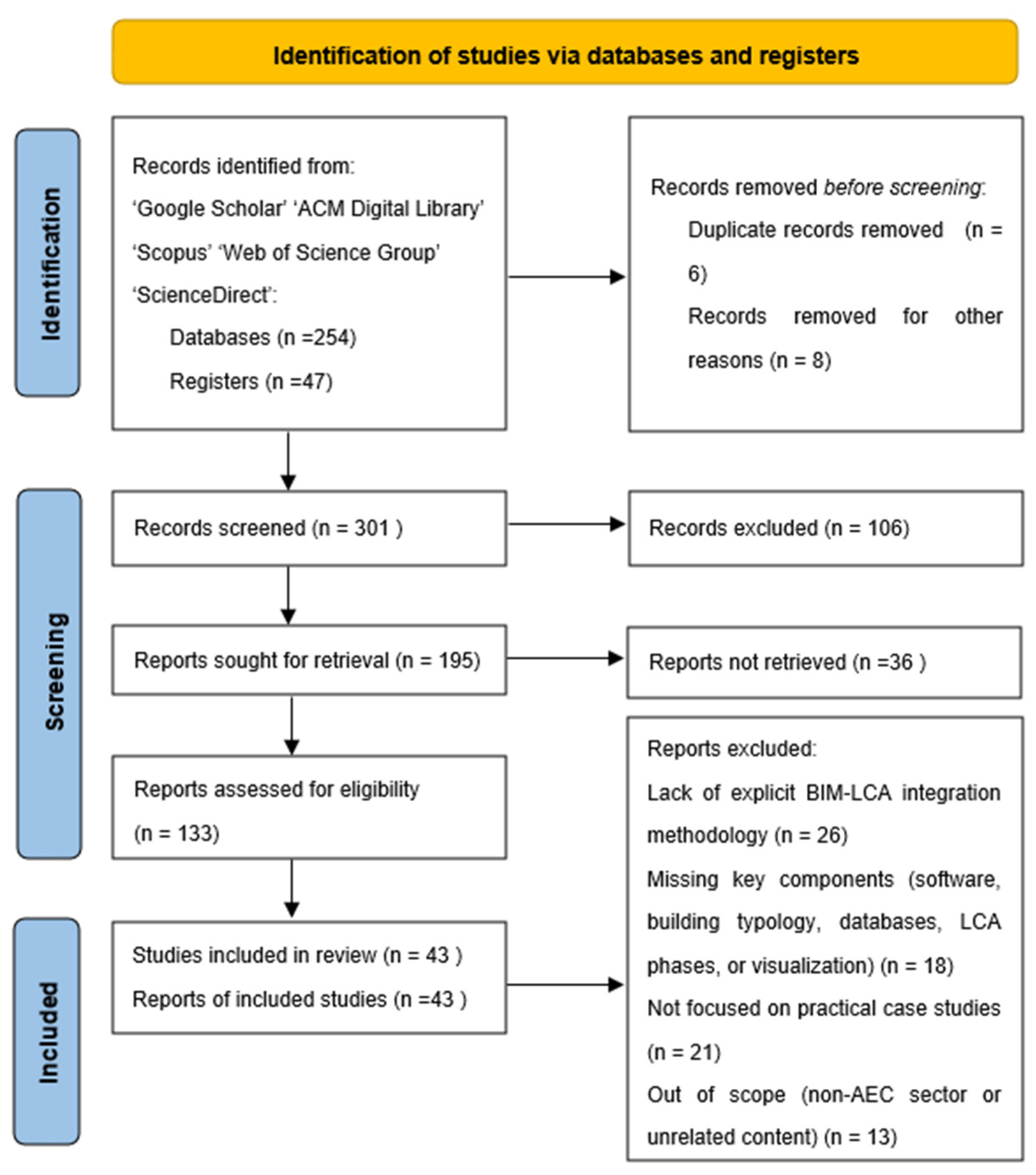
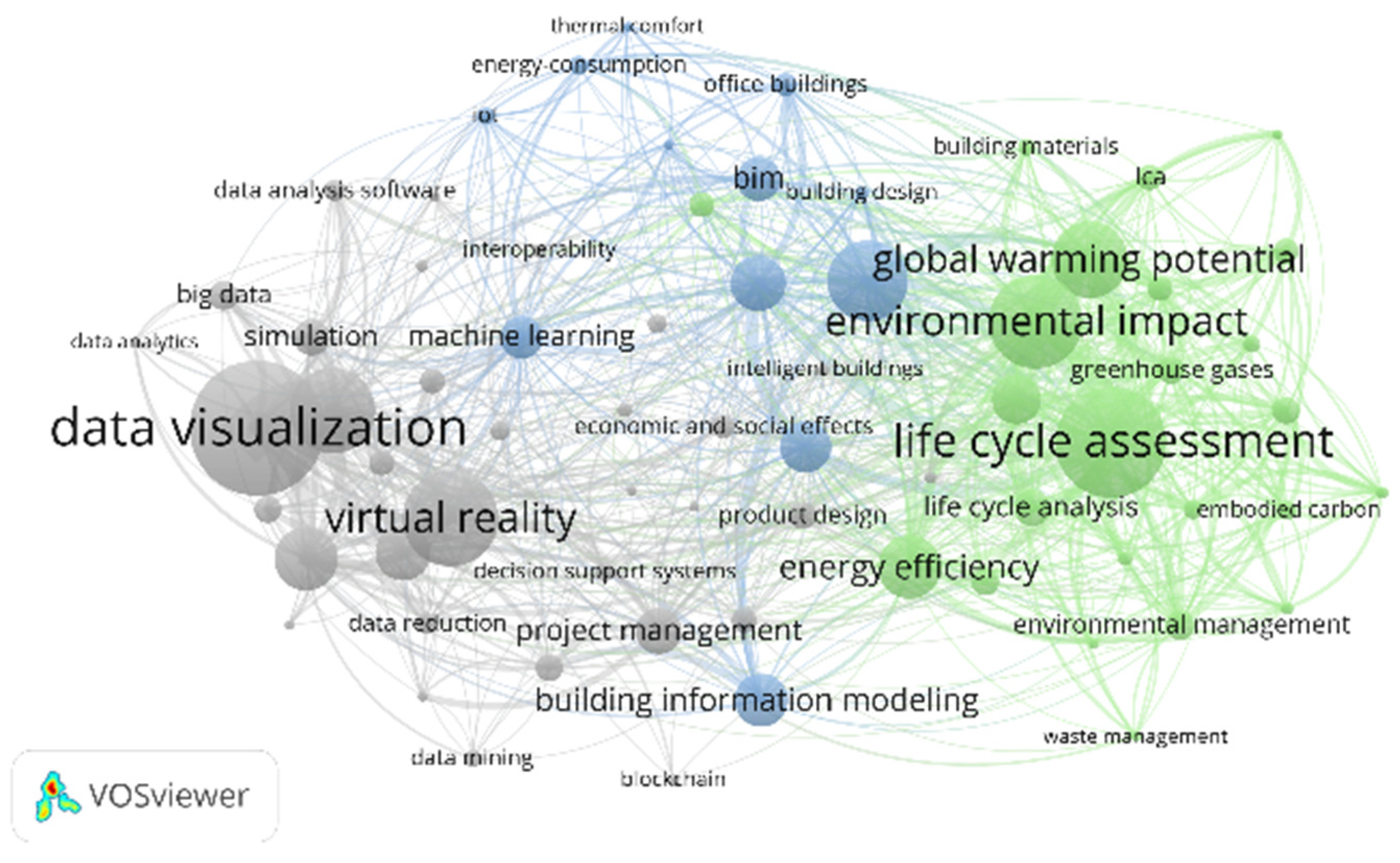
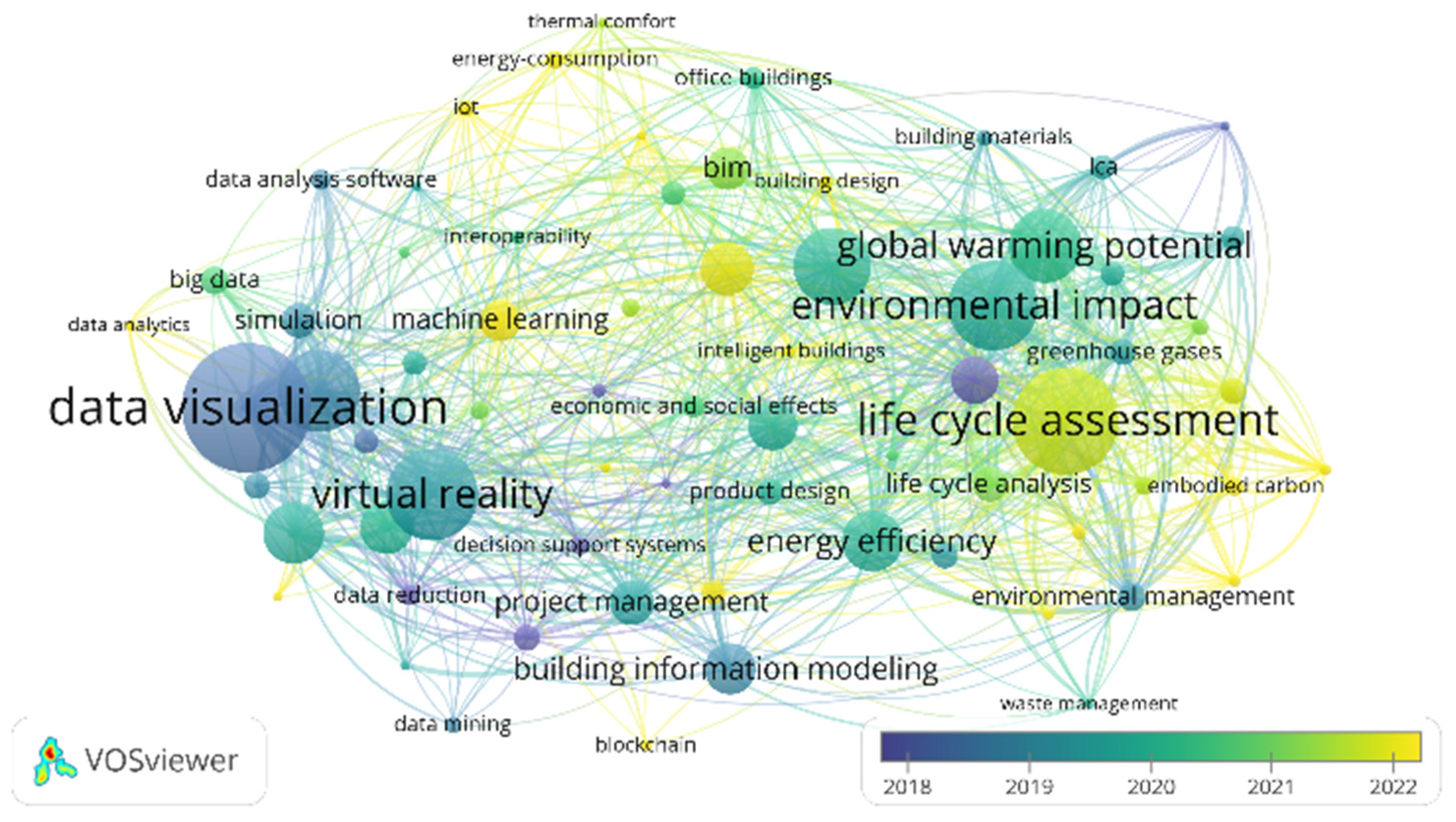
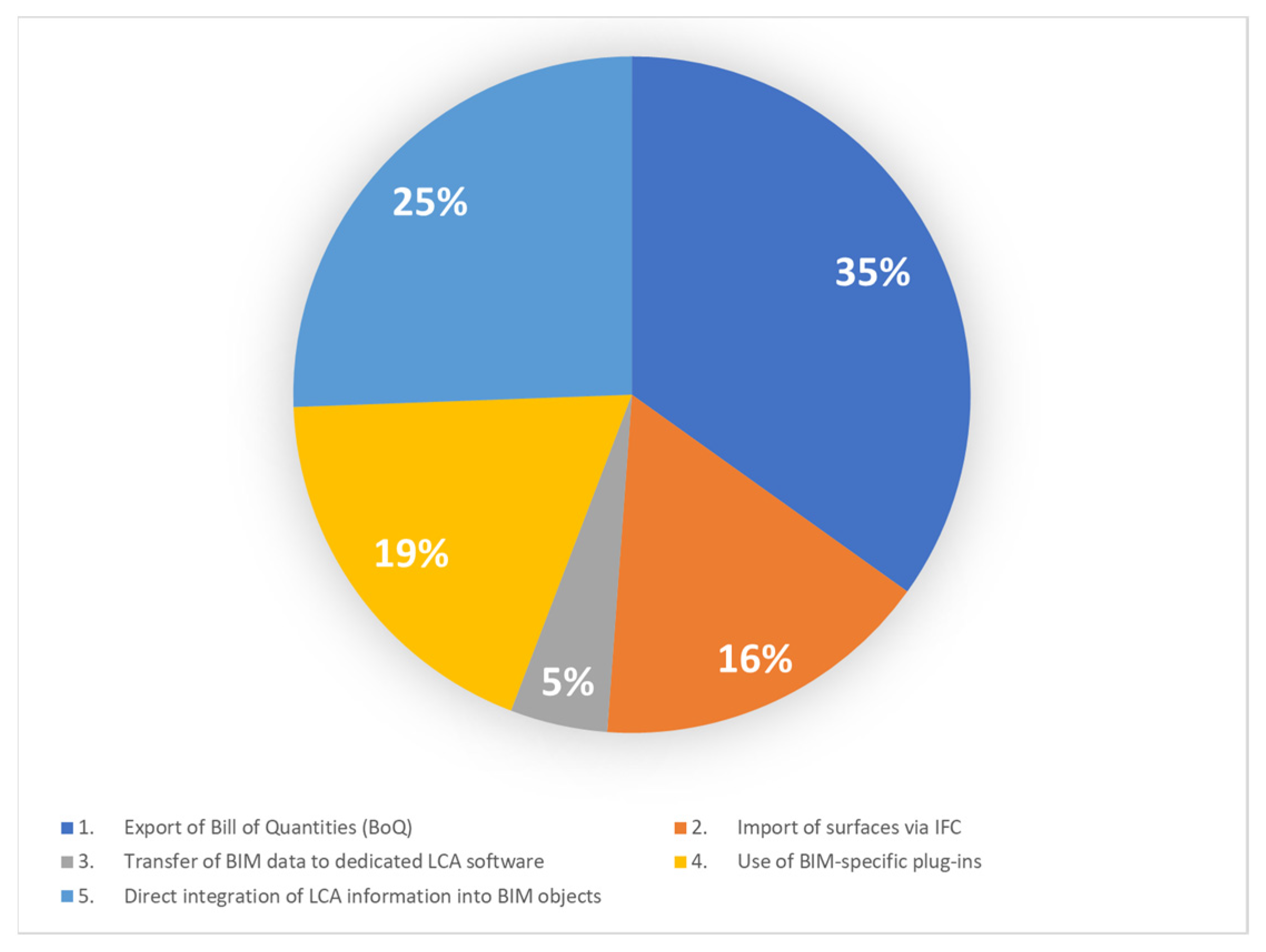
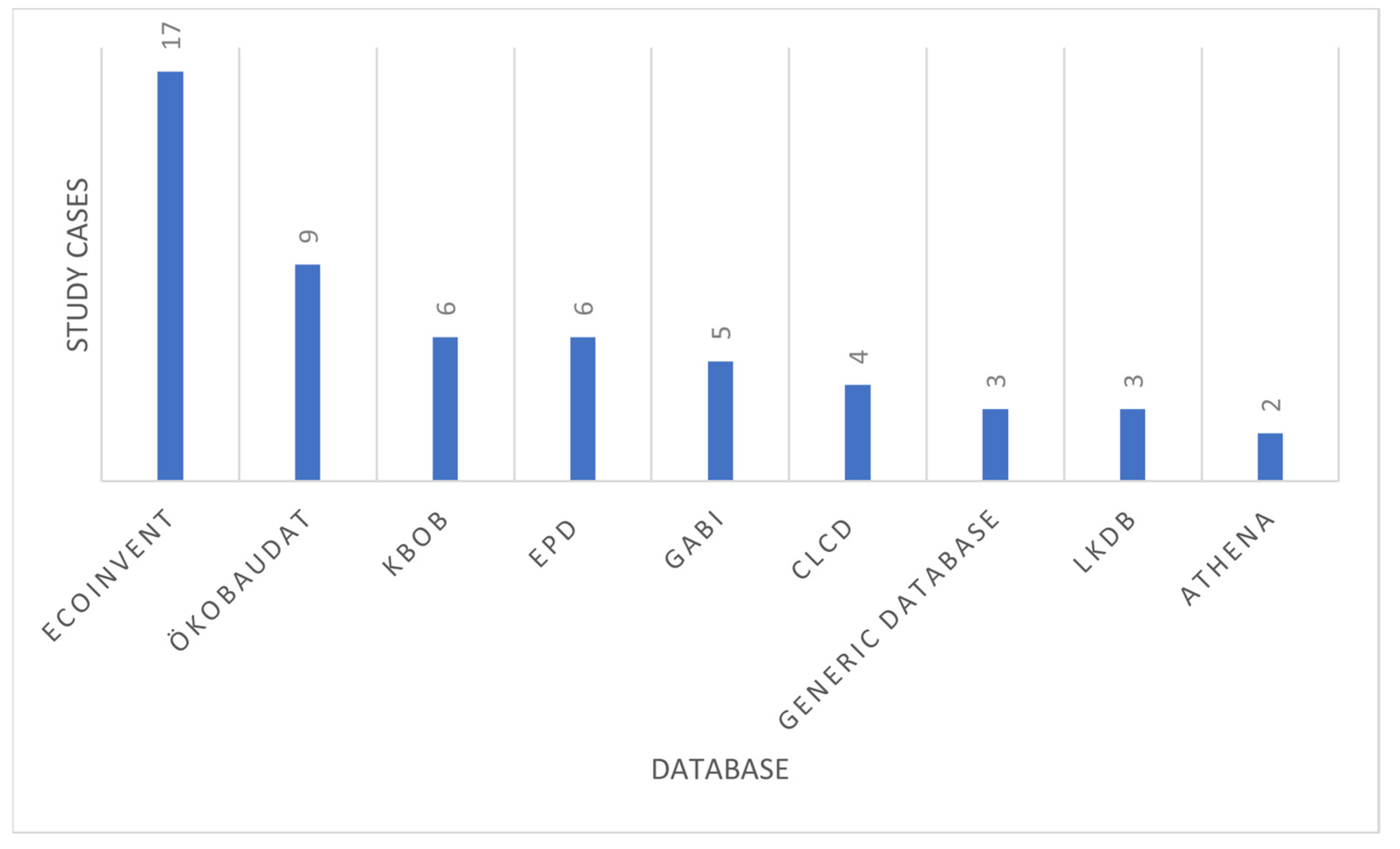


Disclaimer/Publisher’s Note: The statements, opinions and data contained in all publications are solely those of the individual author(s) and contributor(s) and not of MDPI and/or the editor(s). MDPI and/or the editor(s) disclaim responsibility for any injury to people or property resulting from any ideas, methods, instructions or products referred to in the content. |
© 2025 by the authors. Licensee MDPI, Basel, Switzerland. This article is an open access article distributed under the terms and conditions of the Creative Commons Attribution (CC BY) license (https://creativecommons.org/licenses/by/4.0/).
Share and Cite
Bolognesi, C.; Bassorizzi, D.; Balin, S.; Manfredi, V. An Overview on LCA Integration in BIM: Tools, Applications, and Future Trends. Digital 2025, 5, 31. https://doi.org/10.3390/digital5030031
Bolognesi C, Bassorizzi D, Balin S, Manfredi V. An Overview on LCA Integration in BIM: Tools, Applications, and Future Trends. Digital. 2025; 5(3):31. https://doi.org/10.3390/digital5030031
Chicago/Turabian StyleBolognesi, Cecilia, Deida Bassorizzi, Simone Balin, and Vasili Manfredi. 2025. "An Overview on LCA Integration in BIM: Tools, Applications, and Future Trends" Digital 5, no. 3: 31. https://doi.org/10.3390/digital5030031
APA StyleBolognesi, C., Bassorizzi, D., Balin, S., & Manfredi, V. (2025). An Overview on LCA Integration in BIM: Tools, Applications, and Future Trends. Digital, 5(3), 31. https://doi.org/10.3390/digital5030031









